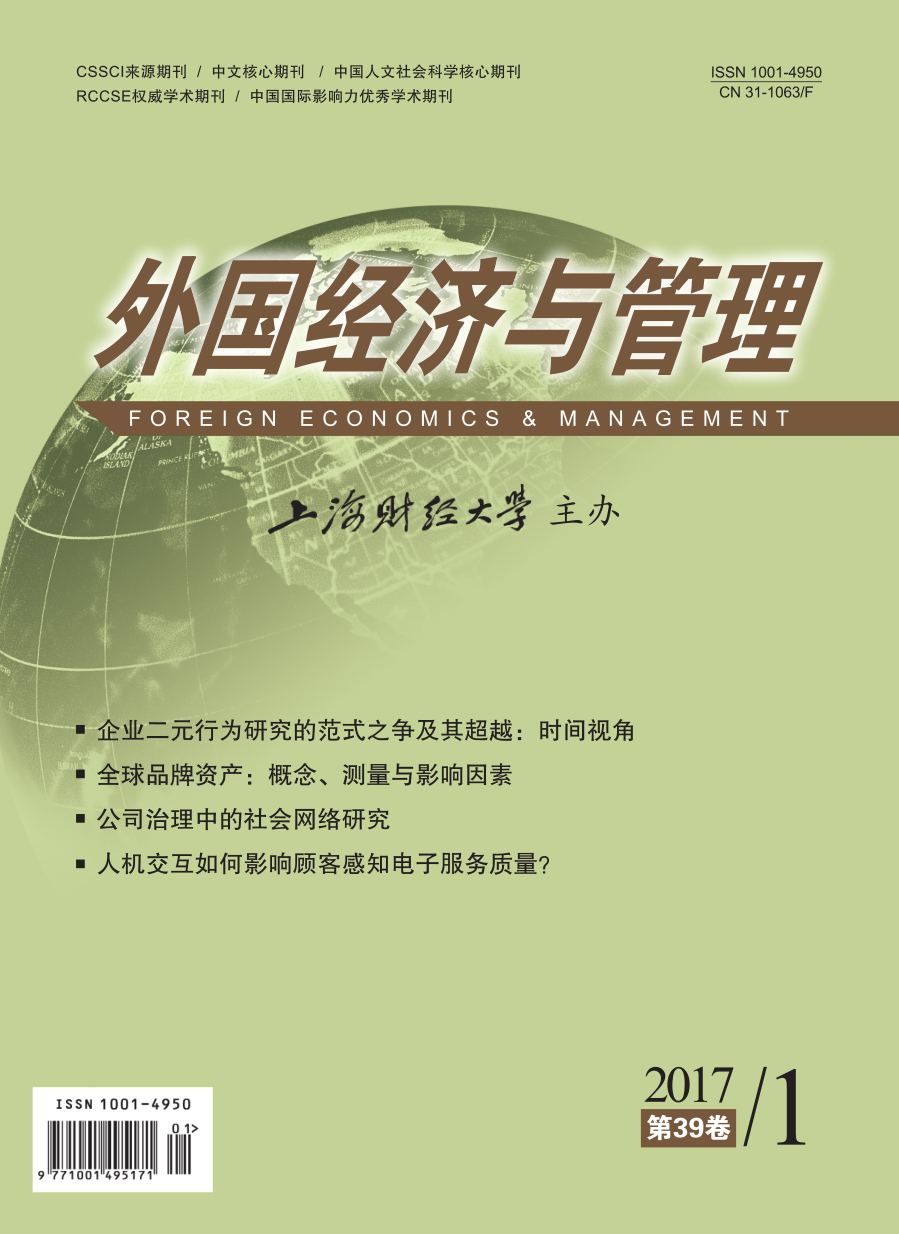企业探索行为和利用行为中隐含着“时间”维度,本文的研究发现:(1)“时间”是二元性和间断平衡这两大企业二元行为研究范式的核心;(2)企业二元性理论和间断平衡理论间的核心分歧在于“时间假设”和“行为的时间模式”的差异性,并由此引发它们在其他相关议题上的不同看法;(3)更加全面的企业二元行为类型应该超越二元性范式和间断平衡范式,这可以由“二元行为序列”(sequence of ambidextrous behavior,SAB)这一研究议题来囊括,可以从单一行为的时间属性、二元行为的时间属性、恰当的理论阐释三个方面来推进相关研究。本文的研究拓宽了二元行为研究的理论视角,弥补了上述两大范式在“时间”维度上的不足,并力图探索二元行为研究的新思路和新方向。
企业二元行为研究的范式之争及其超越:时间视角
摘要
参考文献
3 Amis J, Slack T, Hinings C R. The pace, sequence, and linearity of radical change[J]. Academy of Management Journal, 2004, 47(1):15-39. DOI:10.2307/20159558
4 Ancona D, Chong C L. Entrainment:Pace, cycle, and rhythm in organizational behavior[J]. Research in Organizational Behavior, 1996, 18(3):251-284.
5 Ancona D G, Okhuysen G A, Perlow L A. Taking time to integrate temporal research[J]. Academy of Management Review, 2001, 26(4):512-529.
6 Brown S L, Eisenhardt K M. The art of continuous change:Linking complexity theory and time-paced evolution in relentlessly shifting organizations[J]. Administrative Science Quarterly, 1997, 42(1):1-34. DOI:10.2307/2393807
7 Burgelman R A. Strategy as vector and the inertia of coevolutionary lock-in[J]. Administrative Science Quarterly, 2002, 47(2):325-357. DOI:10.2307/3094808
8 Crossan M, Cunha M P E, Vera D, et al. Time and organizational improvisation[J]. Academy of Management Review, 2005, 30(1):129-145. DOI:10.5465/AMR.2005.15281441
9 Dougherty D, Bertels H, Chung K, et al. Whose time is it? Understanding clock-time pacing and event-time pacing in complex innovations[J]. Management and Organization Review, 2013, 9(2):233-263. DOI:10.1111/more.12017
10 Doz Y L. The evolution of cooperation in strategic alliances:Initial conditions or learning processes?[J]. Strategic Management Journal, 1996, 17(S1):55-83.
11 Gersick C J G. Revolutionary change theories:A multilevel exploration of the punctuated equilibrium paradigm[J]. Academy of Management Review, 1991, 16(1):10-36. DOI:10.5465/AMR.1991.4278988
12 Gibson C B, Birkinshaw J. The antecedents, consequences, and mediating role of organizational ambidexterity[J]. Academy of Management Journal, 2004, 47(2):209-226. DOI:10.2307/20159573
13 Gupta A K, Smith K G, Shalley C E. The interplay between exploration and exploitation[J]. Academy of Management Journal, 2006, 49(4):693-706. DOI:10.5465/AMJ.2006.22083026
14 Han M. Achieving superior internationalization through strategic ambidexterity[J]. Journal of Enterprising Culture, 2007, 15(1):43-77. DOI:10.1142/S0218495807000046
15 Im G, Rai A. Knowledge sharing ambidexterity in long-term interorganizational relationships[J]. Management Science, 2008, 54(7):1281-1296. DOI:10.1287/mnsc.1080.0902
16 Klarner P, Raisch S. Move to the beat-rhythms of change and firm performance[J]. Academy of Management Journal, 2013, 56(1):160-184. DOI:10.5465/amj.2010.0767
17 Laamanen T, Keil T. Performance of serial acquirers:Toward an acquisition program perspective[J]. Strategic Management Journal, 2008, 29(6):663-672. DOI:10.1002/(ISSN)1097-0266
18 Lee H, Liebenau J. Time in organizational studies:Towards a new research direction[J]. Organization Studies, 1999, 20(6):1035-1058. DOI:10.1177/0170840699206006
19 Liguori M. The supremacy of the sequence:Key elements and dimensions in the process of change[J]. Organization Studies, 2012, 33(4):507-539. DOI:10.1177/0170840612443457
20 March J G. Exploration and exploitation in organizational learning[J]. Organization Science, 1991, 2(1):71-87. DOI:10.1287/orsc.2.1.71
21 Mudambi R, Swift T. Proactive R & D management and firm growth:A punctuated equilibrium model[J]. Research Policy, 2011, 40(3):429-440. DOI:10.1016/j.respol.2010.10.014
22 Mueller V, Rosenbusch N, Bausch A. Success patterns of exploratory and exploitative innovation:A meta-analysis of the influence of institutional factors[J]. Journal of Management, 2013, 39(6):1606-1636. DOI:10.1177/0149206313484516
23 Nadkarni S, Chen T X, Chen J H. The clock is ticking! Executive temporal depth, industry velocity, and competitive aggressiveness[J]. Strategic Management Journal, 2016, 37(6):1132-1153. DOI:10.1002/smj.2376
24 O'Reilly Ⅲ C A, Tushman M L. The ambidextrous organization[J]. Harvard Business Review, 2004, 82(4):74-81.
25 Orlikowski W J, Yates J. It's about time:Temporal structuring in organizations[J]. Organization Science, 2002, 13(6):684-700. DOI:10.1287/orsc.13.6.684.501
26 Pérez-Nordtvedt L, Payne G T, Short J C, et al. An entrainment-based model of temporal organizational fit, misfit, and performance[J]. Organization Science, 2008, 19(5):785-801. DOI:10.1287/orsc.1070.0330
27 Raisch S, Birkinshaw J, Probst G, et al. Organizational ambidexterity:Balancing exploitation and exploration for sustained performance[J]. Organization Science, 2009, 20(4):685-695. DOI:10.1287/orsc.1090.0428
28 Romanelli E, Tushman M L. Organizational transformation as punctuated equilibrium:An empirical test[J]. Academy of Management Journal, 1994, 37(5):1141-1166. DOI:10.2307/256669
29 Schriber J B, Gutek B A. Some time dimensions of work:Measurement of an underlying aspect of organization culture[J]. Journal of Applied Psychology, 1987, 72(4):642-650. DOI:10.1037/0021-9010.72.4.642
30 Shi W L, Prescott J E. Rhythm and entrainment of acquisition and alliance initiatives and firm performance:A temporal perspective[J]. Organization Studies, 2012, 33(10):1281-1310. DOI:10.1177/0170840612453530
31 Smith W K, Tushman M L. Managing strategic contradictions:A top management model for managing innovation streams[J]. Organization Science, 2005, 16(5):522-536. DOI:10.1287/orsc.1050.0134
32 Stettner U, Lavie D. Ambidexterity under scrutiny:Exploration and exploitation via internal organization, alliances, and acquisitions[J]. Strategic Management Journal, 2014, 35(13):1903-1929. DOI:10.1002/smj.2195
33 Vermeulen F, Barkema H. Pace, rhythm, and scope:Process dependence in building a profitable multinational corporation[J]. Strategic Management Journal, 2002, 23(7):637-653. DOI:10.1002/(ISSN)1097-0266
34 Zaheer S, Albert S, Zaheer A. Time scales and organizational theory[J]. Academy of Management Review, 1999, 24(4):725-741.
引用本文
岑杰. 企业二元行为研究的范式之争及其超越:时间视角[J]. 外国经济与管理, 2017, 39(1): 3–14.
导出参考文献,格式为:
上一篇:中国乡村创业理论构建与未来展望






 8008
8008  6627
6627

